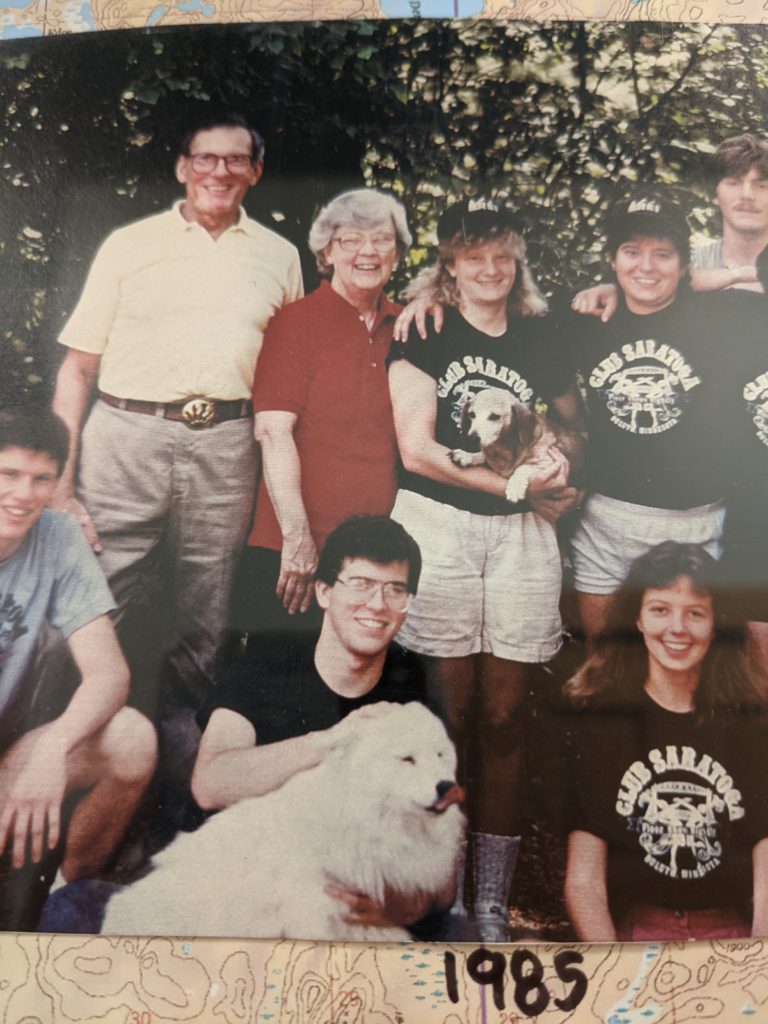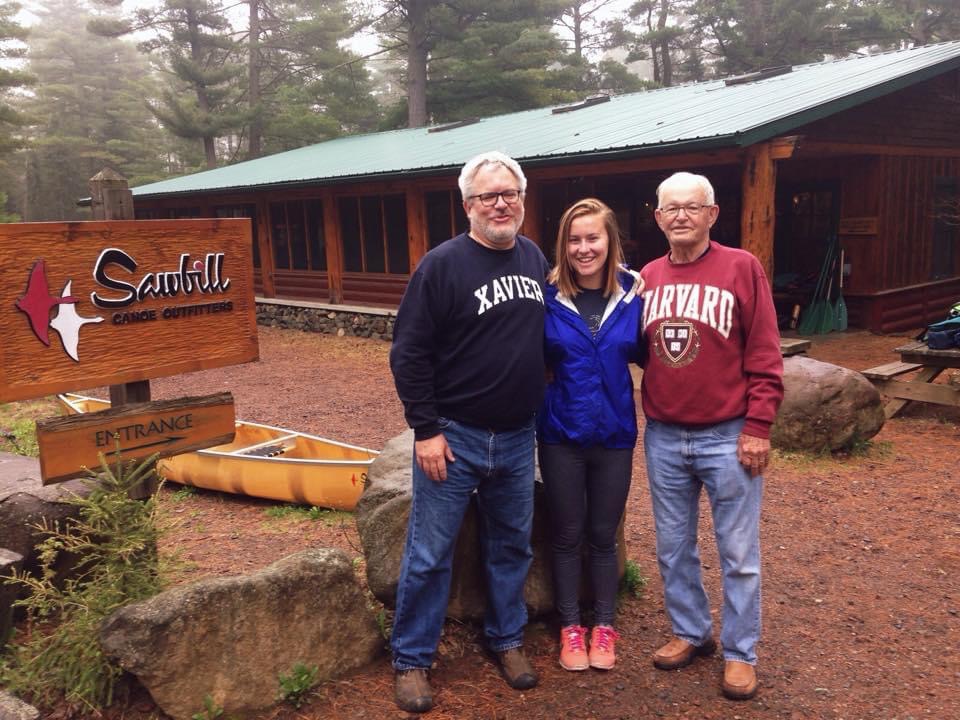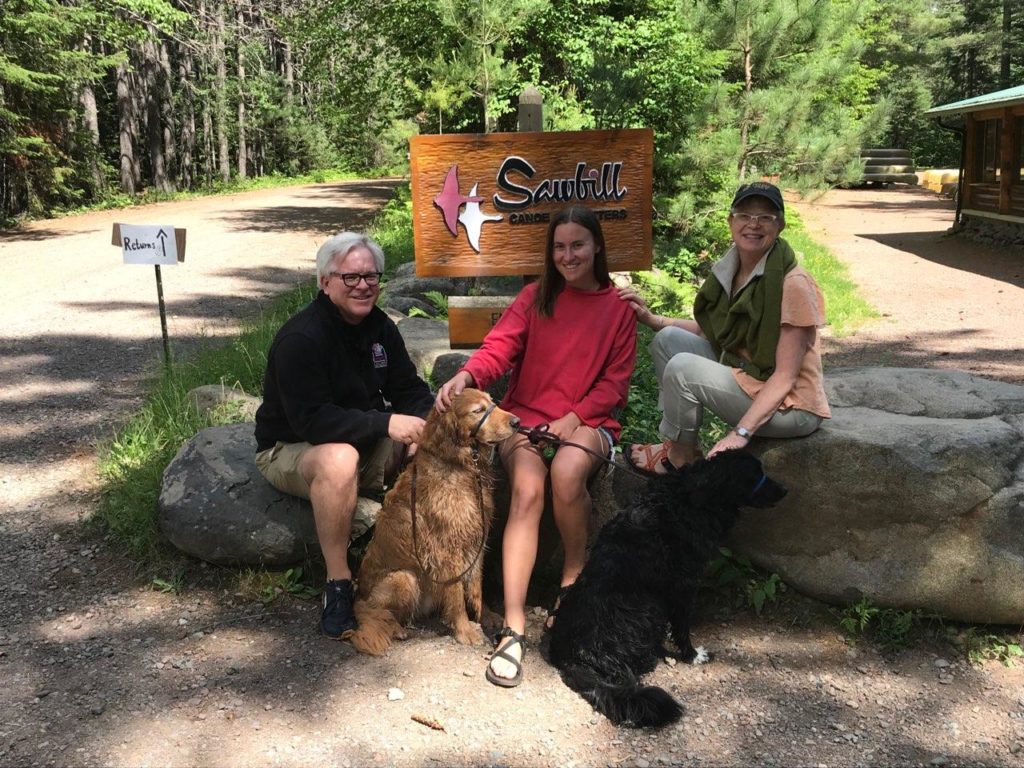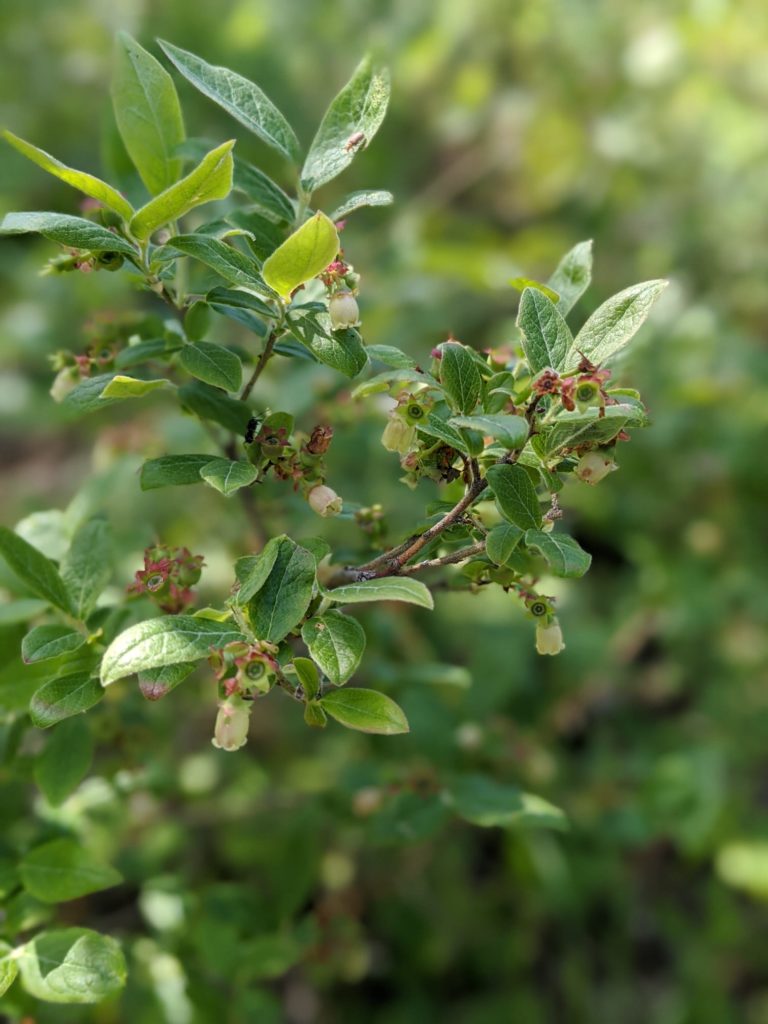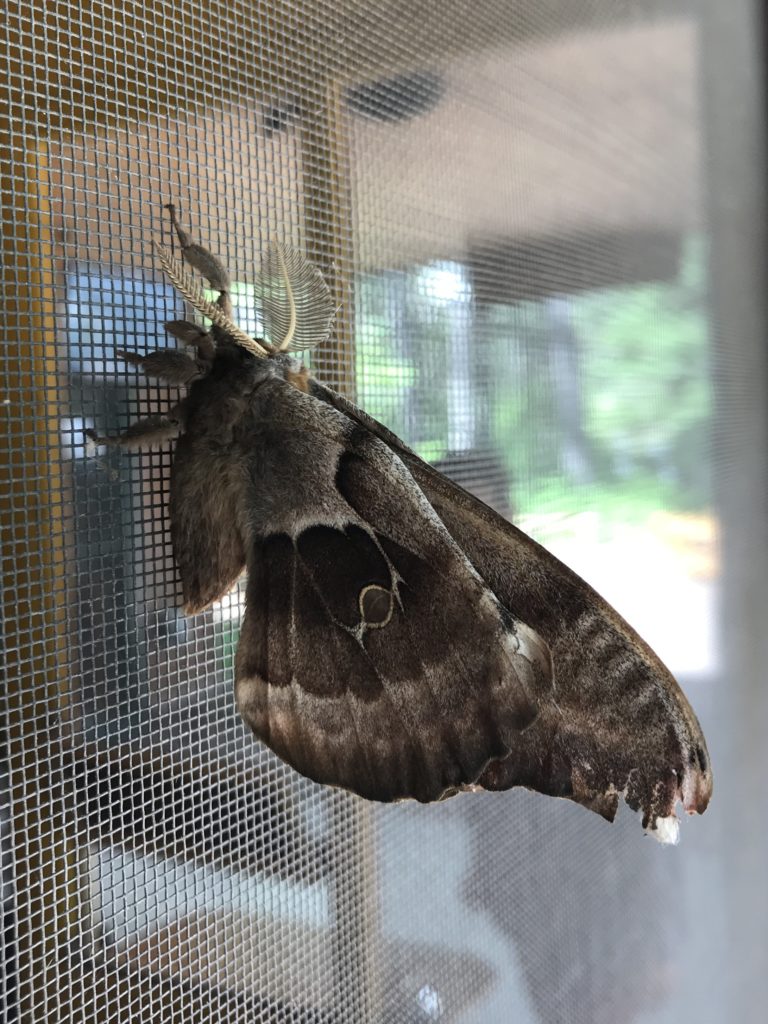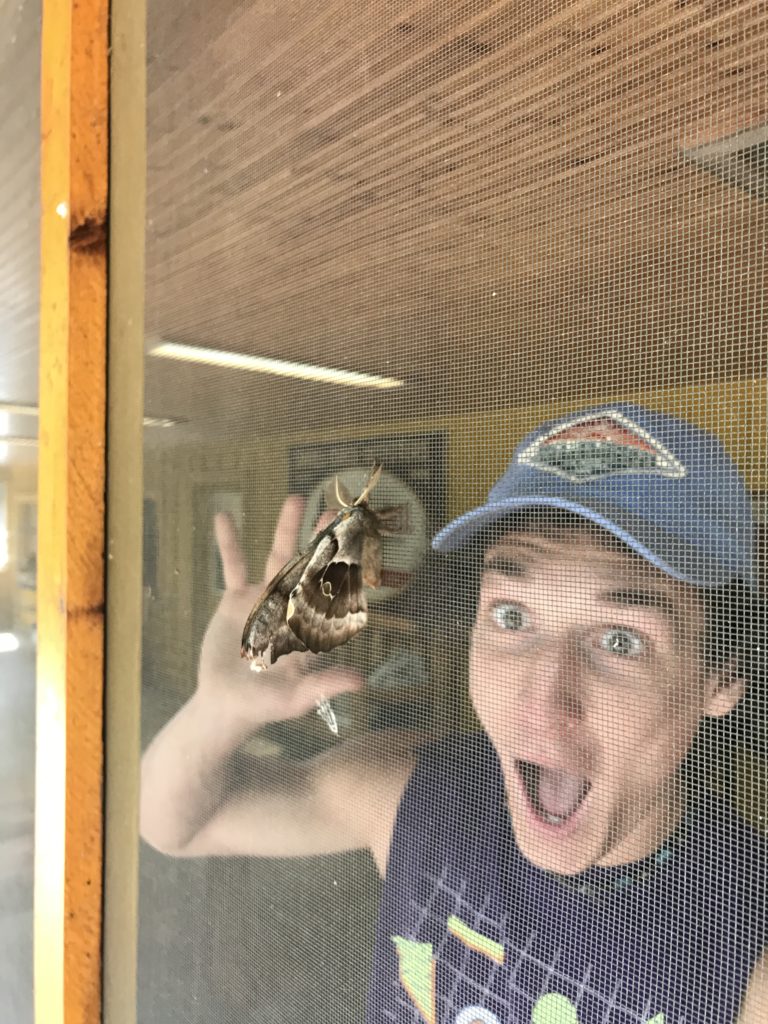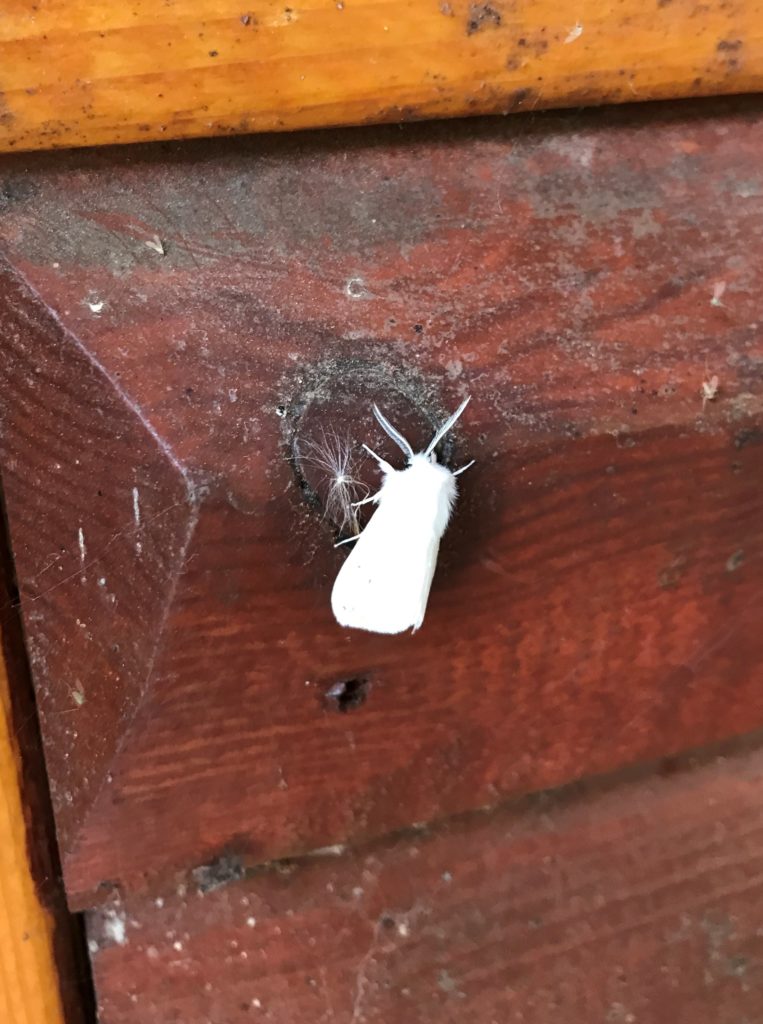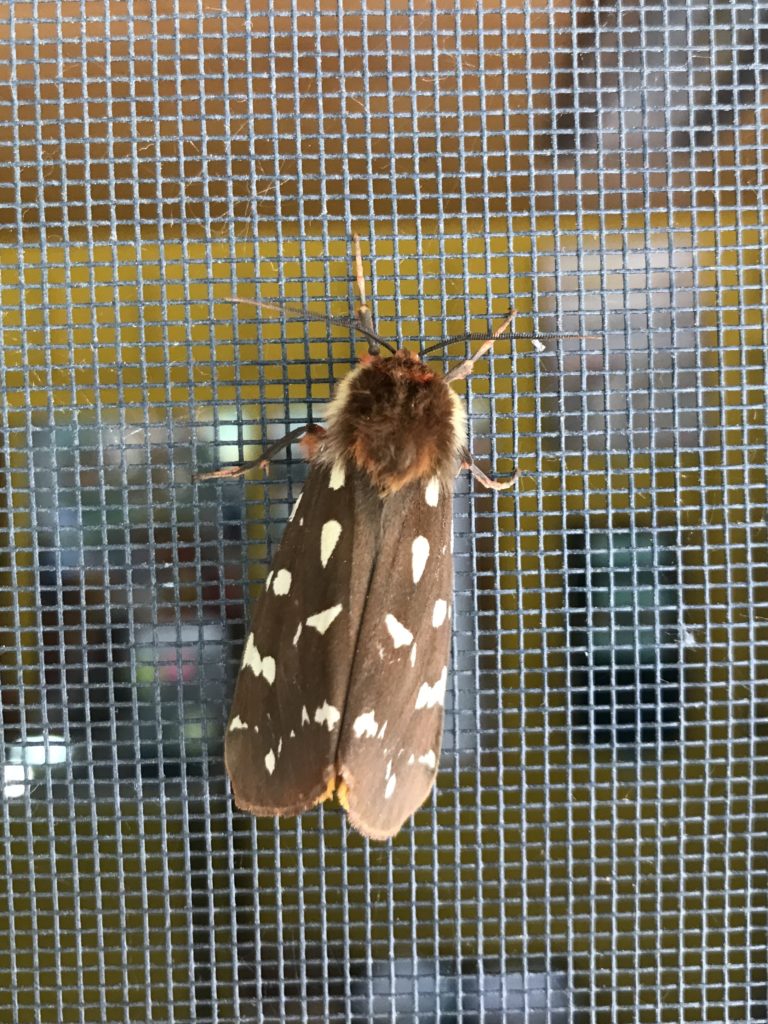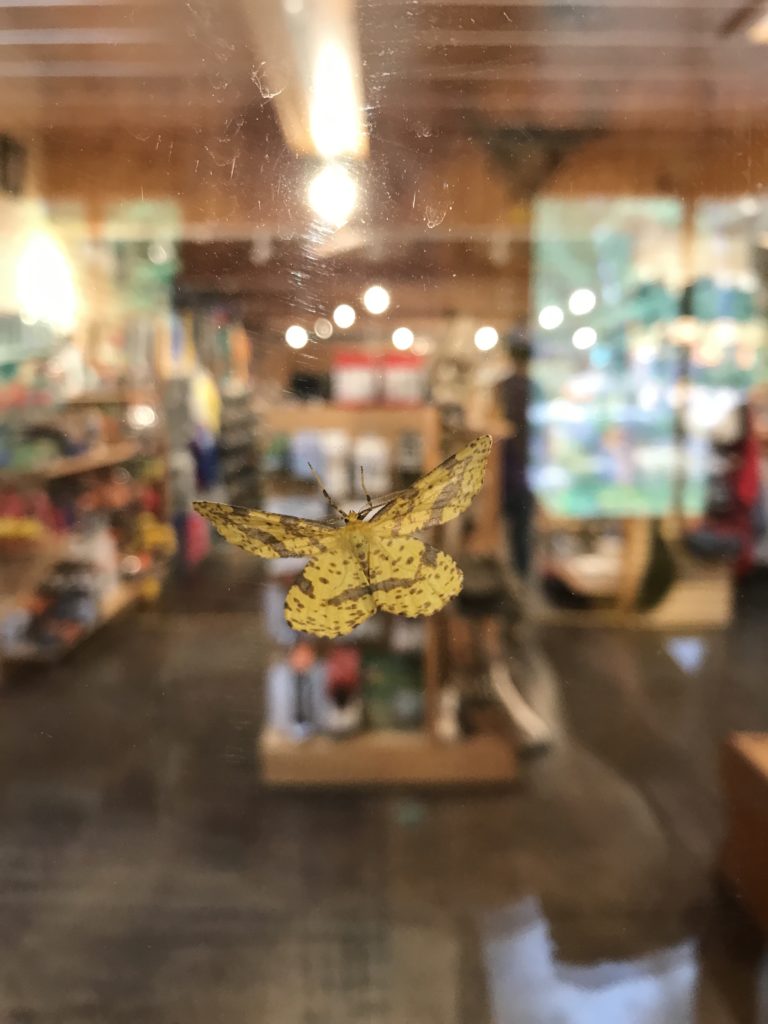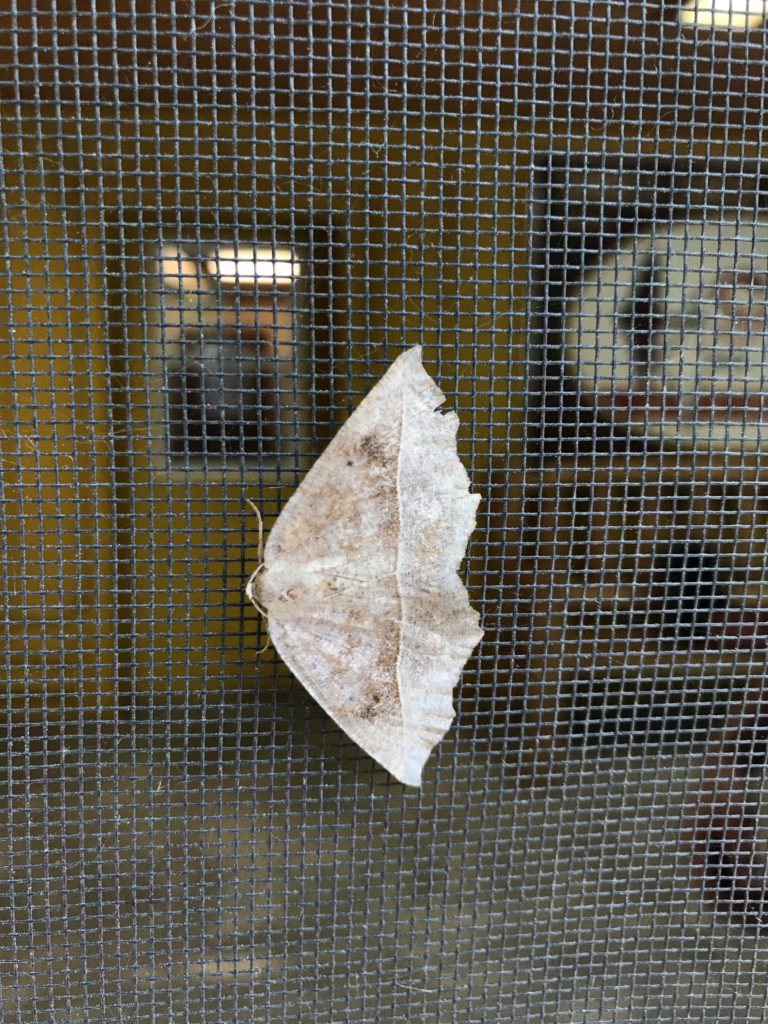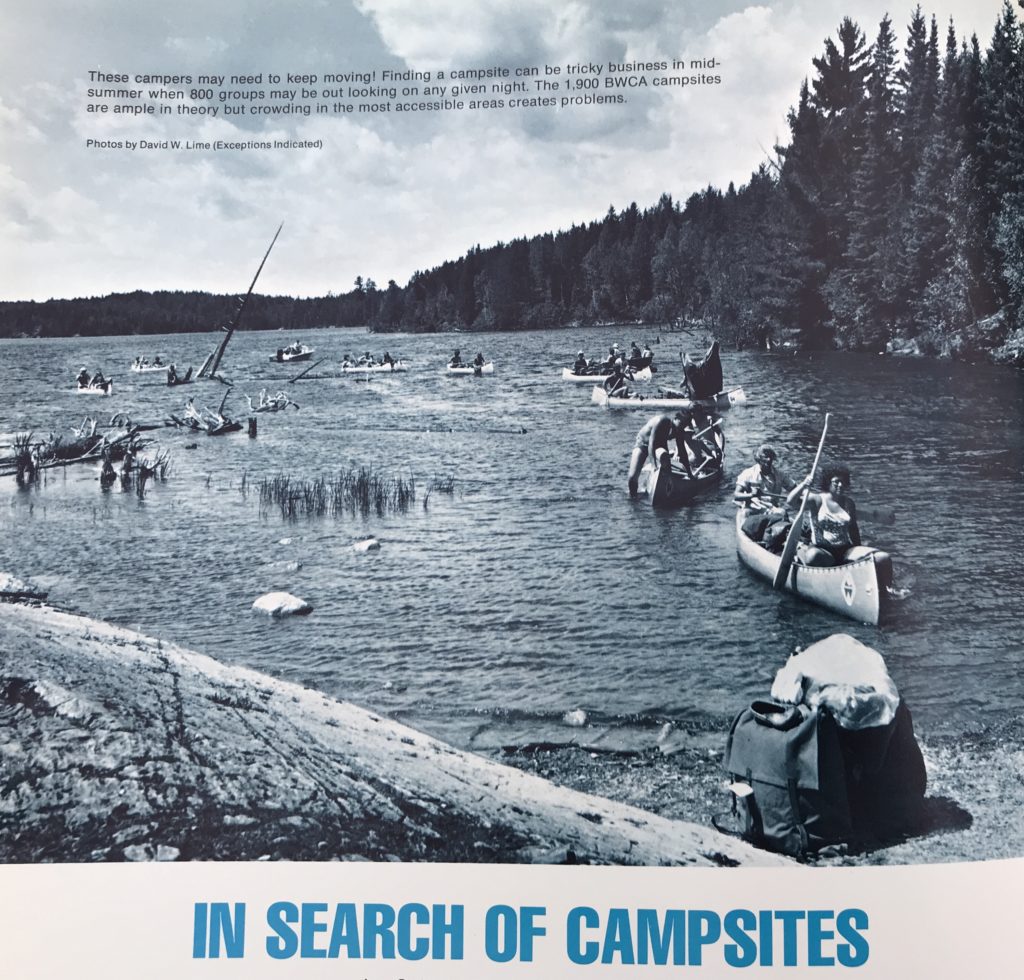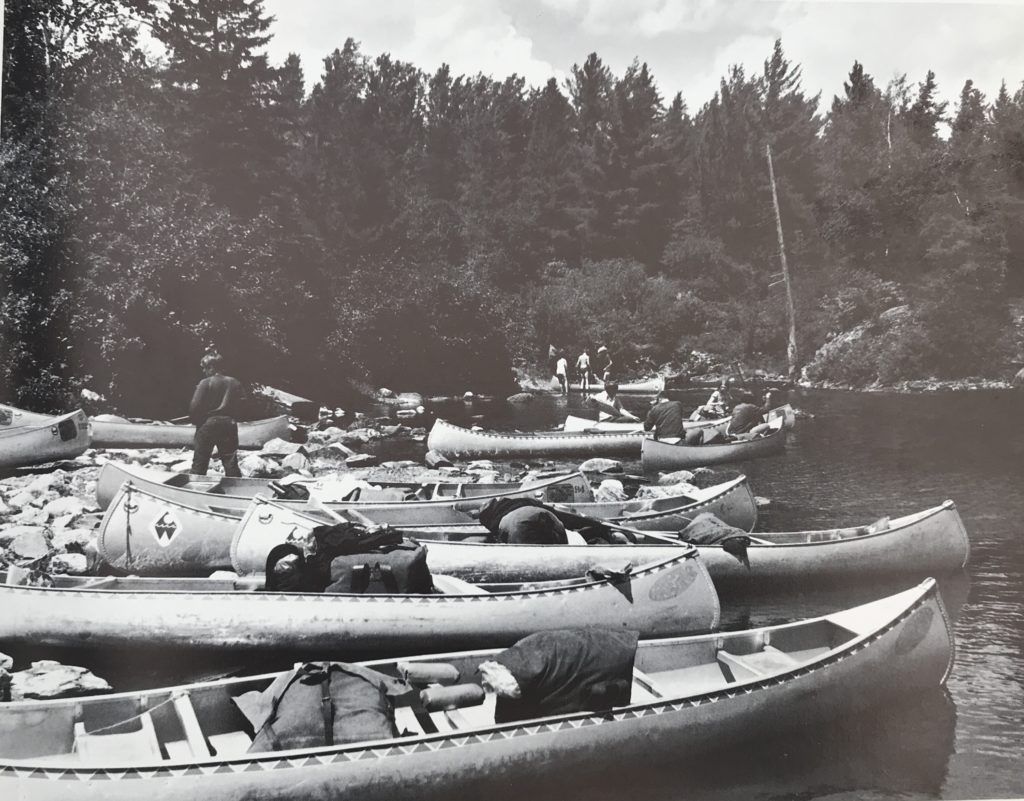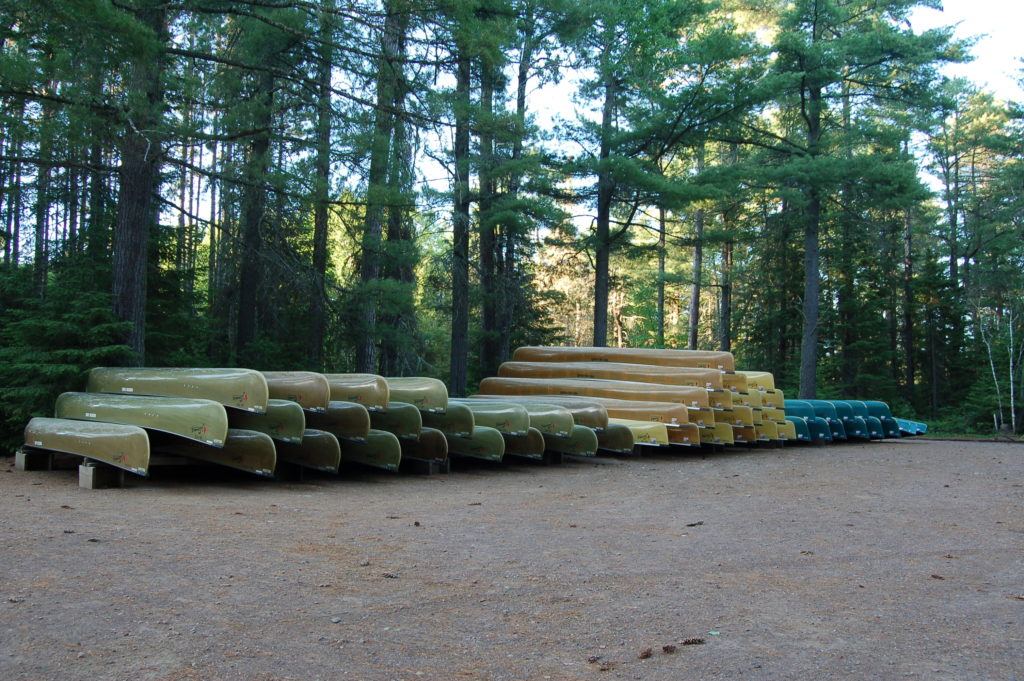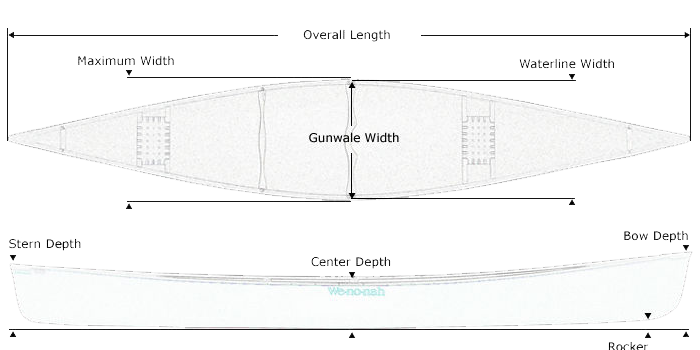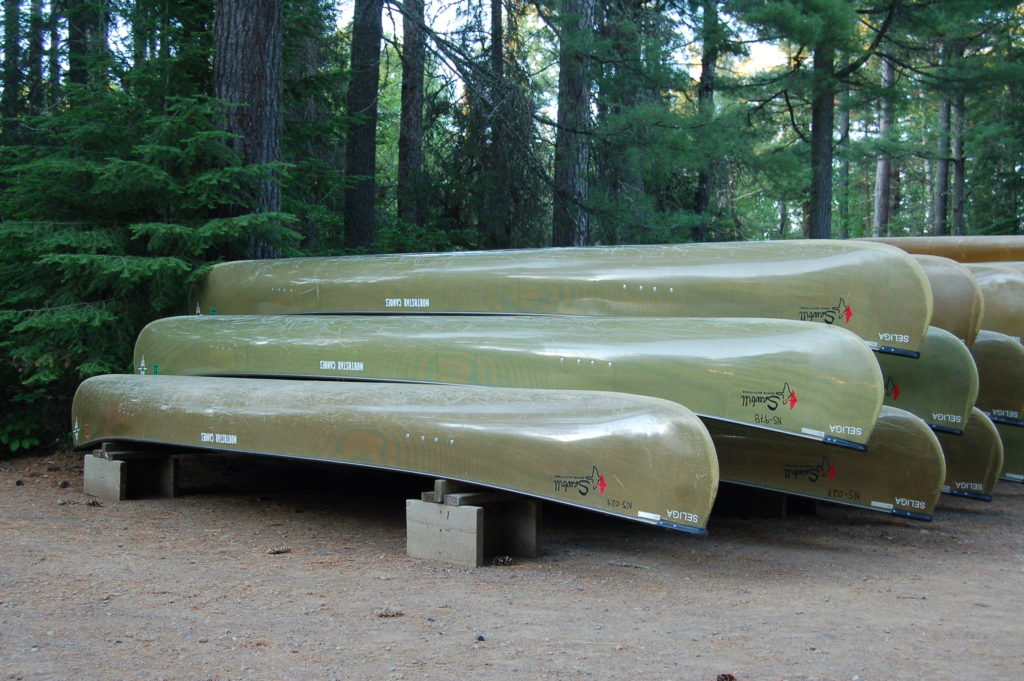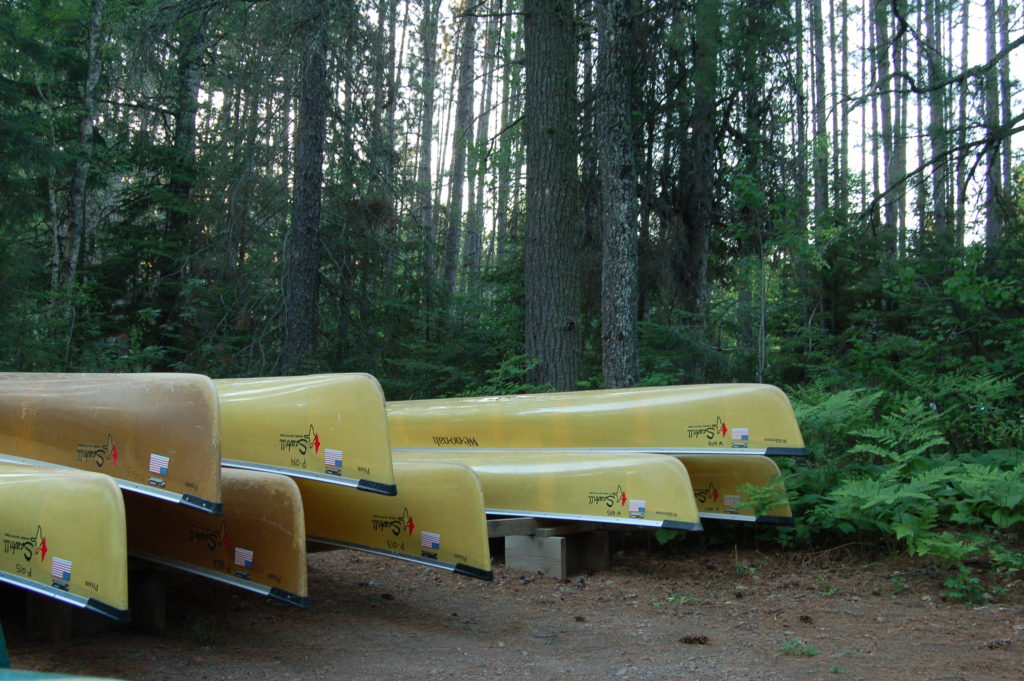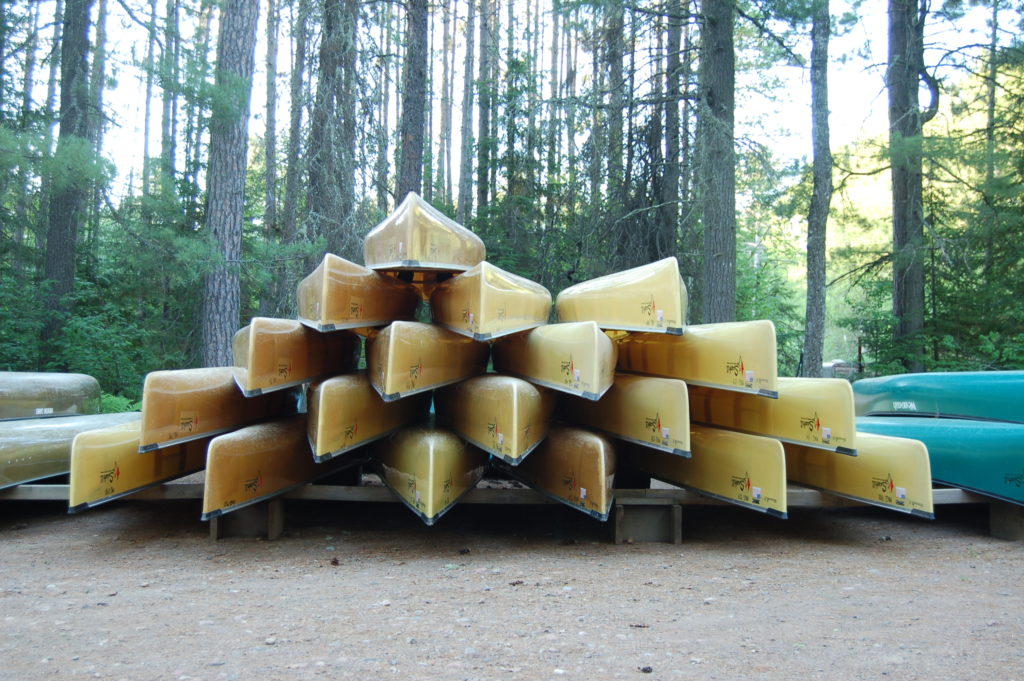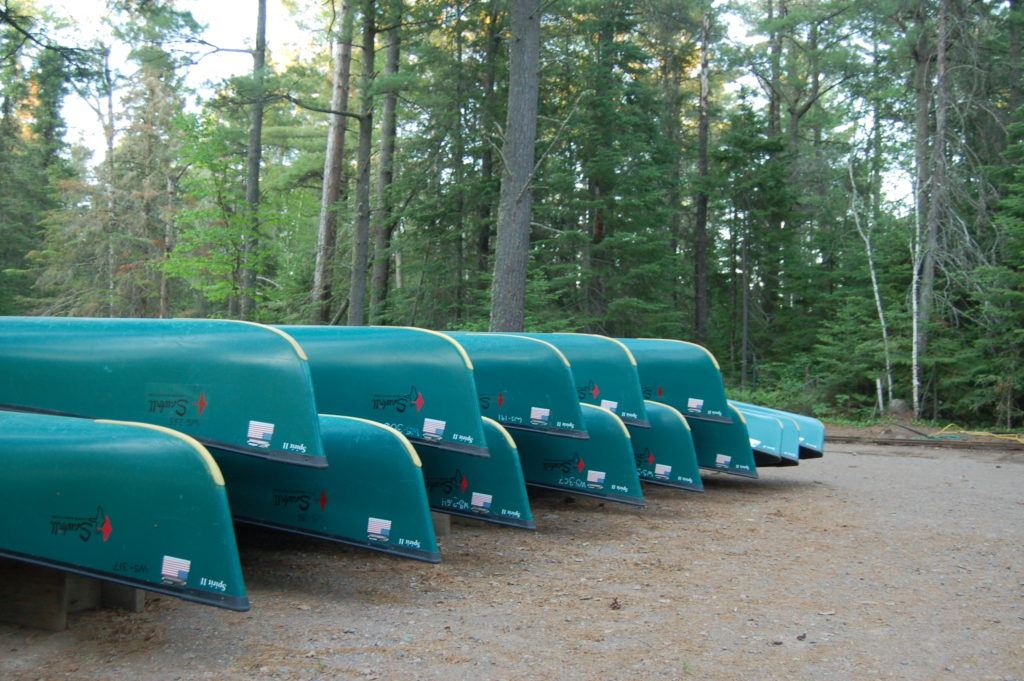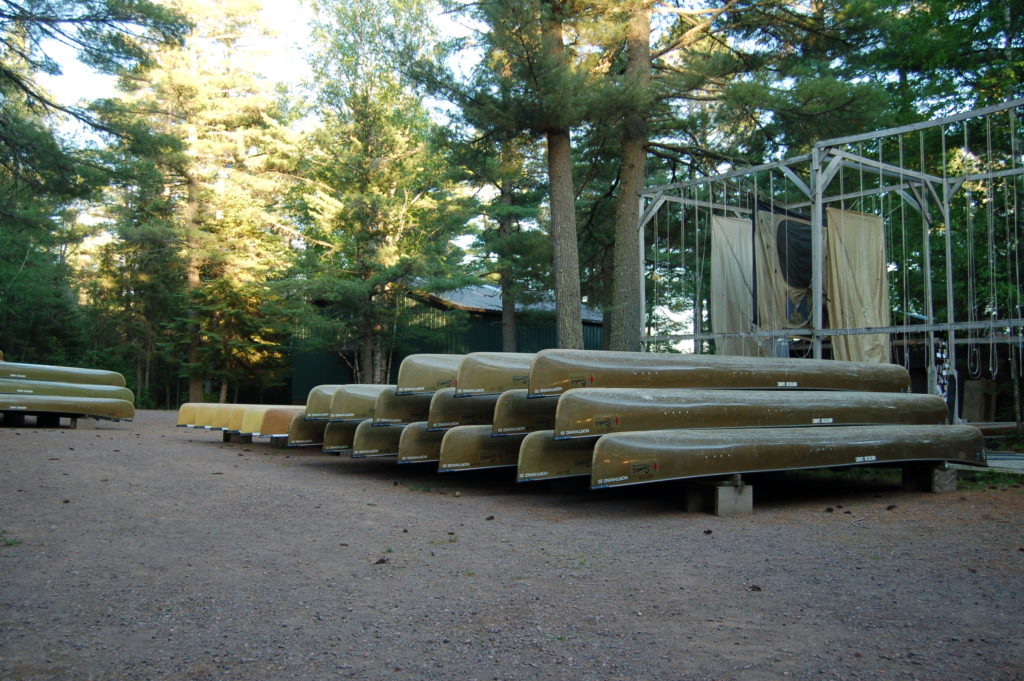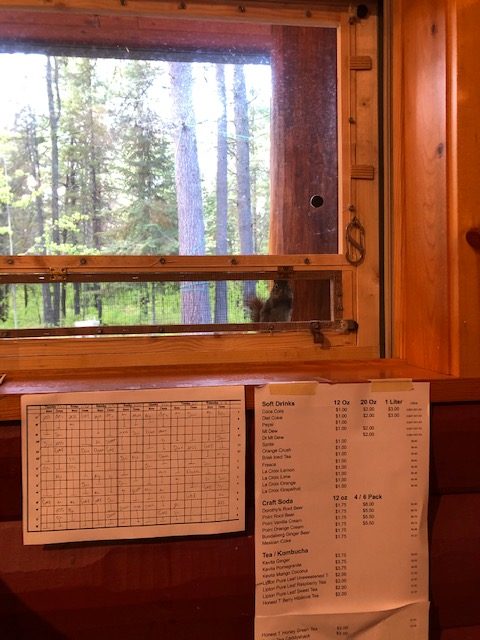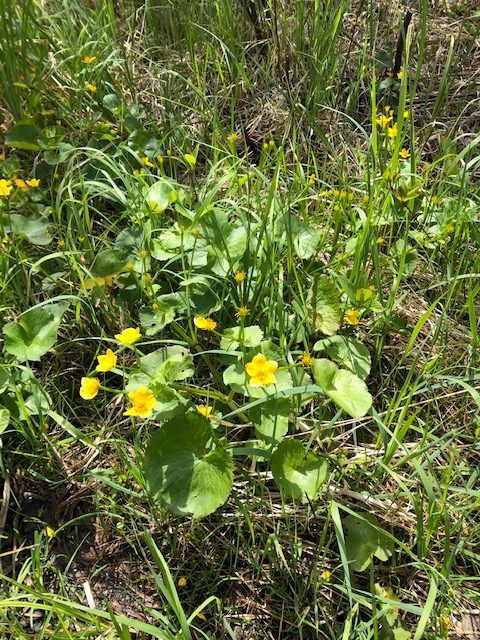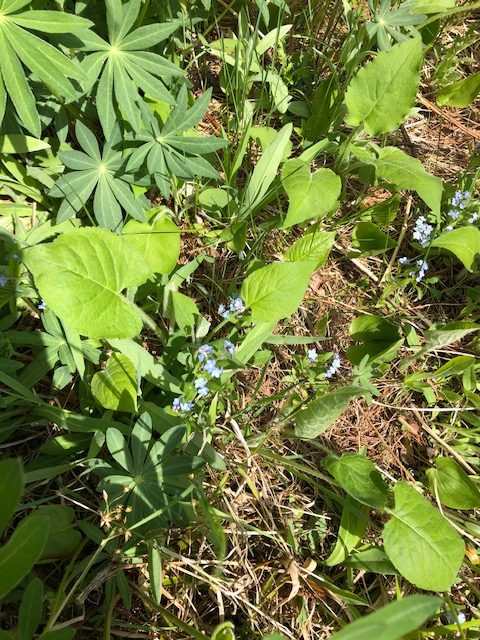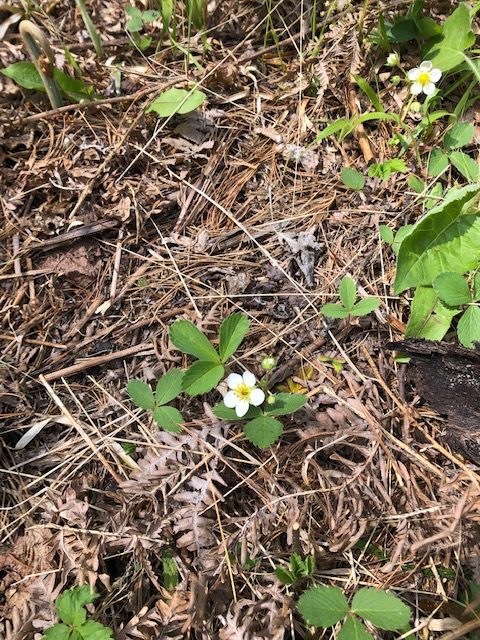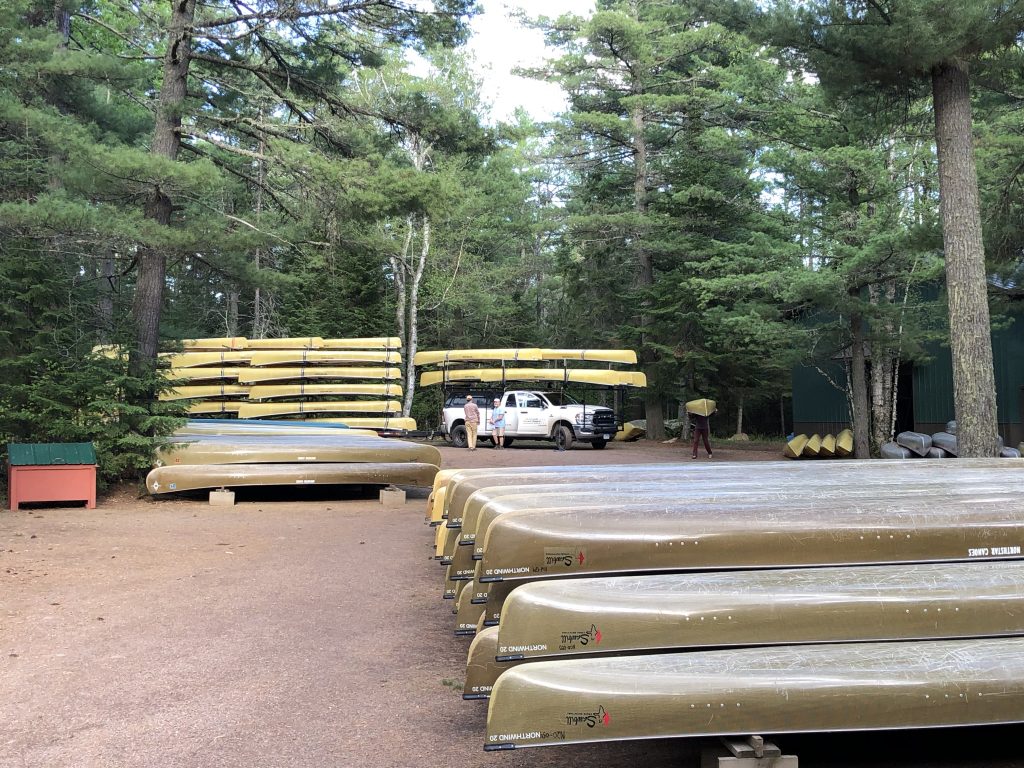6/22/21 – This year for my annual father/daughter canoe trip with Kit (5), we decided to do the Cherokee Loop, beginning and ending at the landing on Sawbill Lake. Kit has been eyeing up the Cherokee Loop since our return from 2 nights on Wine Lake last summer. Clare and the Sawbill crew graciously gave us a few days off, so we went for it.
We launched at about 8am on Thursday June 17th. We loaded our moderately packed Granite Gear Superior 1 pack along with Kit’s small backpack and another day pack into a Northstar B16. The B16 is a great option for paddling with kids because it has symmetrical rocker so it can be paddled “backwards”, turning the bow seat into a stern seat that is closer to the center of the canoe. Without a thwart behind the front seat (as is usually in place with larger canoes), this is an easy adaptation. Kit is a good paddler for a 5 year old, but only takes strokes occasionally, so I effectively solo paddle us around.
Our plan was to do the loop backwards (counter clockwise), so we headed for the portage to Smoke Lake and made it there in good time with a light tail wind and warm sun. We met a group coming off the portage who had just left camp on Burnt that morning. We proceeded across the 100 rod portage and talked to two more groups on the Smoke side who were also exiting from a stay on Burnt. With this intel, we felt good about our prospects for finding a campsite.
We decided to do the loop backwards for this exact reason – give ourselves the best chance at a campsite on Burnt by arriving early in the day. You see, there has been a trend toward folks base camping on Sawbill, Alton, Smoke and Burnt, causing some congestion on those lakes and more campsite pressure. (Folks traveling a bit farther rarely ever have issues with campsite availability).
The paddle across Smoke was pretty quick, aided by a stiffer west northwest wind. We gathered our gear for the 90 rods to Burnt. We checked out a few sites and ultimately decided to stay on the site on the north side of the narrows as you enter the lake.
With plenty of daylight left, we ate lunch, set up camp and spent the rest of the day swimming and fishing from shore. We didn’t catch any fish, but maybe the bald eagle soaring above our swimming hole did. We had a nice campfire with roasted hot dogs and smores for dinner. It was a fun quintessential camp experience. Despite a relatively easy travel day, we were in bed by 6:30pm for some book reading.
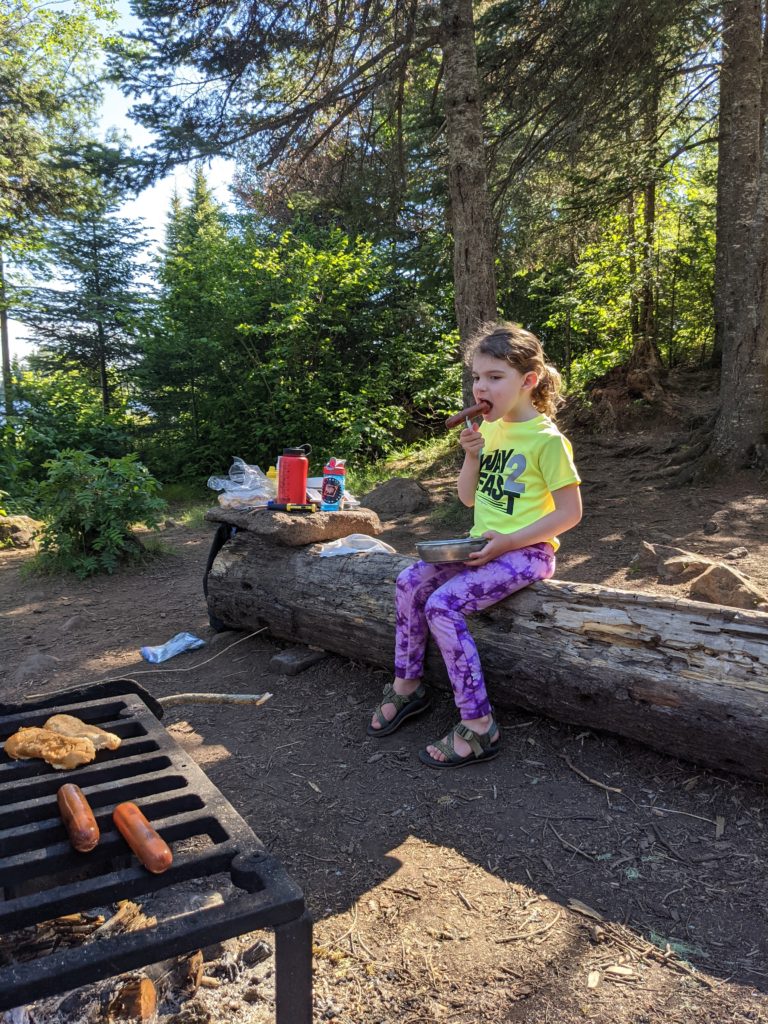

Up at 5am the next day, we packed up camp as we had a breakfast of ramen noodles and coffee (for me). The day started calm and beautiful, with long morning shadows cast across the lake and vibrant green canopy blanketing the far shore.

On the water by 6:30am, our day was off to a good start. The short paddle across the middle of Burnt brought us to the first portage of the day, 230 rods into Kelly.
I hoisted the Superior 1 to my back and caribinered the day pack to my front, paddles and life jackets strapped inside the canoe that came up onto my shoulders. Kit shouldered her pack and off we went with all our gear. We have a pretty good system down allowing us to single portage every time. Our not yet acclimated muscles had us take a quick break midway across the portage.
As we shoved off onto Kelly Lake, the breeze had started to pick up, coming out of the south. It aided us along as we made our way up the lake. We stopped and drifted toward the north while I treated (steripen) a couple of bottles of water. The stiff tail wind was welcome during the remainder of our paddle through the narrow meandering section of Kelly. A couple of groups passed by heading south, offering perspective to our good fortune of the wind direction.
A quick 65 rods and we were on Jack. Much to our surprise our nice tail wind was now blowing into our faces, swirling on Jack, as we readied to launch. A short ways up the lake a beaver dam formed a barrier that needed negotiating. Wind gusts beared down hard as I paddled toward the dam. A gust shoved us off kilter and spun the bow of the canoe to the side. I couldn’t back paddle quickly enough to get us turned before the bow slammed sideways into a rock, rattling my partner. Spinning around for a second attempt, I was able to nose up to the dam. I climbed out onto the dam and pulled the canoe up and over, avoiding the need to unload anything or anyone else. Now on the other side, a strong kick and we were navigating into the swirling and gusting wind, thankful that the lake was too small and narrow to produce any significant waves from the stiff wind.
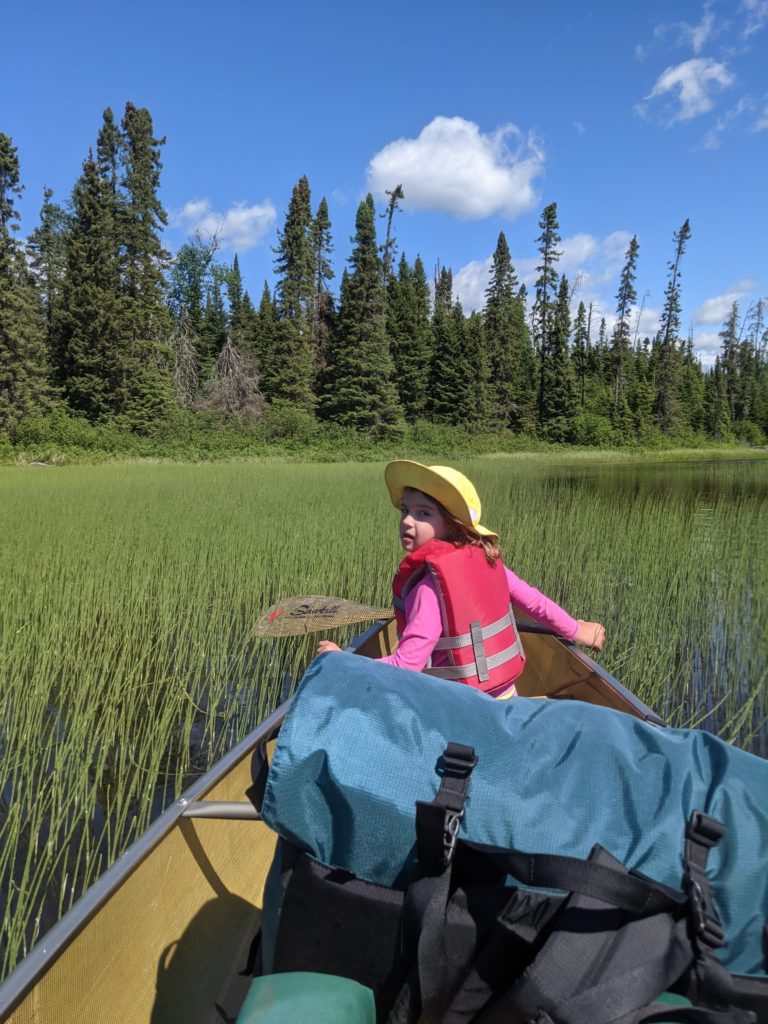
The campsite on the north side of Jack is slightly mis-placed on the Makenzie map. It appears right next to the narrows that lead you out of the north side of the lake. In reality the campsite is farther to the east. As a result, we were lured over to the site, creating a minor detor and backtrack into the wind. Once we were on track exiting through the narrows to the north, we decided to land on a rock outcropping for lunch. We dined on peanut butter tortillas, string cheese and cookies.
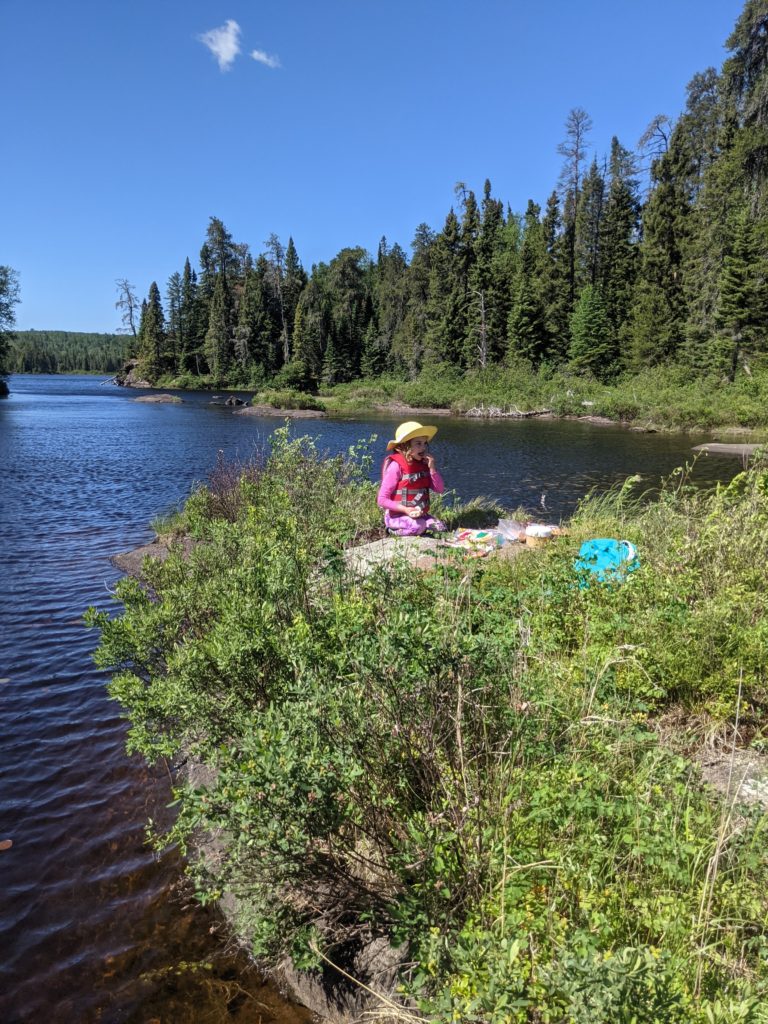
Making our way up through this boggy section toward the portage into Weird Lake, a cow moose appeared around the bend. We slowed and watched as she ate and marfed around. When she sensed our presence she gently walked back up onto shore, delicately lifting and placing her long gangly legs,back into the woods. Continuing on, we looked toward the west as we went by the spot she was in and sure enough she was standing in the woods with a calf at her side. The calf saw us and skittered under her mom. Kit and I exchanged smiles and thumbs up – and plodded on toward the portage, gusts bearing down on us.
A short portage into Weird and another beaver dam to scale up and over welcoming us to this next body of water. This time we were able to approach without issue, making the transition quickly. The single campsite on the lake appeared on our right as we passed by. It was available and looked kind of like a nice one on the small lake. Turning toward the northeast, the wind was now at our backs carrying us to our next portage. Nearing the portage, a strong gust blew Kit’s paddle from her hands as she switched sides. Quick reflexes from Dad and the paddle was rescued without detour or incident. Another quick 80 rod portage and we were on a small unnamed zig zag.
Despite its small size, this was the biggest paddling challenge so far of the day. As we proceeded out of the northeast pointing section, turning back to the west, the wind was hammering us. I made three attempts, each time getting blown back requiring me to back paddle and spin around in order to try again. With some help from my bow paddler, we were finally able to get across the east/west section and turn back toward the south before swinging around to the north and into the landing at the portage.
Coming down the 240 rod portage from South Temperance was a group of Sawbill customers with three canoes – two tandems and a solo. The solo paddler was soaking wet having just capsized on South Temperance. We compared notes for a few minutes about open campsites to the south and conditions on South Temperance. The group was a little rattled from the conditions they had just navigated. Because they were double portaging and now had empty hands, they graciously offered to carry a couple of our things as we all headed north across the portage. Kit got to saunter across unencumbered and I only had to carry the canoe along with the Superior 1 pack on my back.
Arriving at the landing on South Temperance, the wind was gusting hard out of the northwest, pummeling the portage. Large white caps covered the lake while waves crashed on the portage. Kit and I decided to sit tight and wait for things to improve while the other folks headed toward the south. We sat windbound for a couple of hours, watching the choppy lake, planning how to proceed. If I wasn’t effectively solo paddling and had an adult in the bow, we would have launched right away and I feel confident we could have navigated the conditions without issue. When traveling the Wilderness, making safe decisions is a priority in any case. Traveling with your small children really brings that priority into focus.
While we waited we watched another group come down the lake and then helped them land at the portage. I held their canoe so they could unload and clamber to shore. They were completely soaked and there were a few inches of water in the canoe from a recent capsizing.
Once safely on shore, we quizzed them about open campsites, in particular the site just across the southeast bay from the portage. They mentioned that it appeared to be open, although it is high up on a cliff so they couldn’t be sure.
We continued to wait and watch the lake while they completed a double portage toward the south.
The lake seemed like it was calming a bit and we were both getting anxious to get off that portage and across to that campsite. We decided to gear up and get ready for a window without big gusts.
I’m not sure that window ever came, but we felt ready. Launching the canoe faced straight into the wind and waves, my resolute 5 year old paddling partner and I shoved off. We both dug in and made good progress out into the lake. I plopped down on my knees in the middle of the canoe to give me a bit of leverage for turning as we strained forward. Our progress across the bay was good, but we were losing ground on making the point where the campsite was. I set my sights on a large exposed rock along the shore, but we came up a little short. Instead we came into a thicket of sweetgale lining the shore. I was able to grab onto this woody shoreline shrub and hold the canoe facing directly into the wind and waves, waiting for the heavy gust to abate. After several minutes of white knuckled grip while the canoe bucked and bounced, we decided to paddle forward again and try to make the rock just up ahead. However, once I let my grip of the sweetgale go, we were immediately blown backwards and sideways. I was able to quickly back paddle to turn a 180 with the stern now facing into the wind and draw us toward a different big rock and break in the sweetgale thicket. As we neared the shore, I jumped out of the canoe to land us and to avoid smashing in. The water was about chest deep due to the steep shore line. Immediately after I was in the water, I noticed the gunwale going under and Kit heading over the side, following me. I steadied the canoe and hollered for her to climb back in. I then clambered up the rock and hauled the partially submerged canoe, gear and Kit up onto shore. Quickly securing things and dumping out the water from the canoe, we were safe and sound. Kit was a little freaked out – and wet – from the ordeal, but otherwise fine. Once we gathered our composure, we bushwacked into the woods to seek out the campsite, quickly picking up a small trail that brought us right to it. Thankfully it was not occupied so we decided to end our day there at about 4pm.

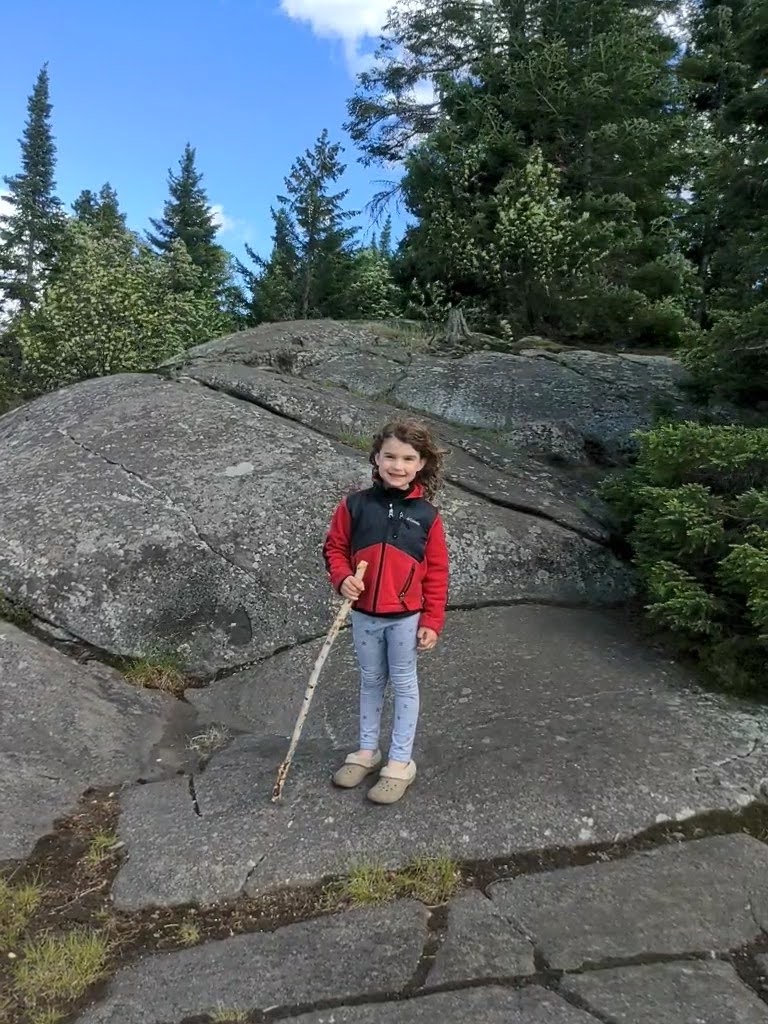
That evening we dried out the gear and clothes that got wet and enjoyed the views from the cliftop site. We decided against a campfire due to the wind, opting for hanging out on the rocks and reflecting on the long day. Oftentimes a hallmark of popular campsites are the habituated critters that hang out on the periphery and dip and dive into the action whenever possible. In addition to the standard squirrel and chipmunk duo, we happened across a large painted turtle pawing at our tent door. When I noticed the rustling and headed over to check it out, the big lumbering animal sauntered off into the woods leaving a startled trail of water (pee?) in its path. I’m glad we didn’t leave the door open or we might have been crawling into an incubation chamber that night!
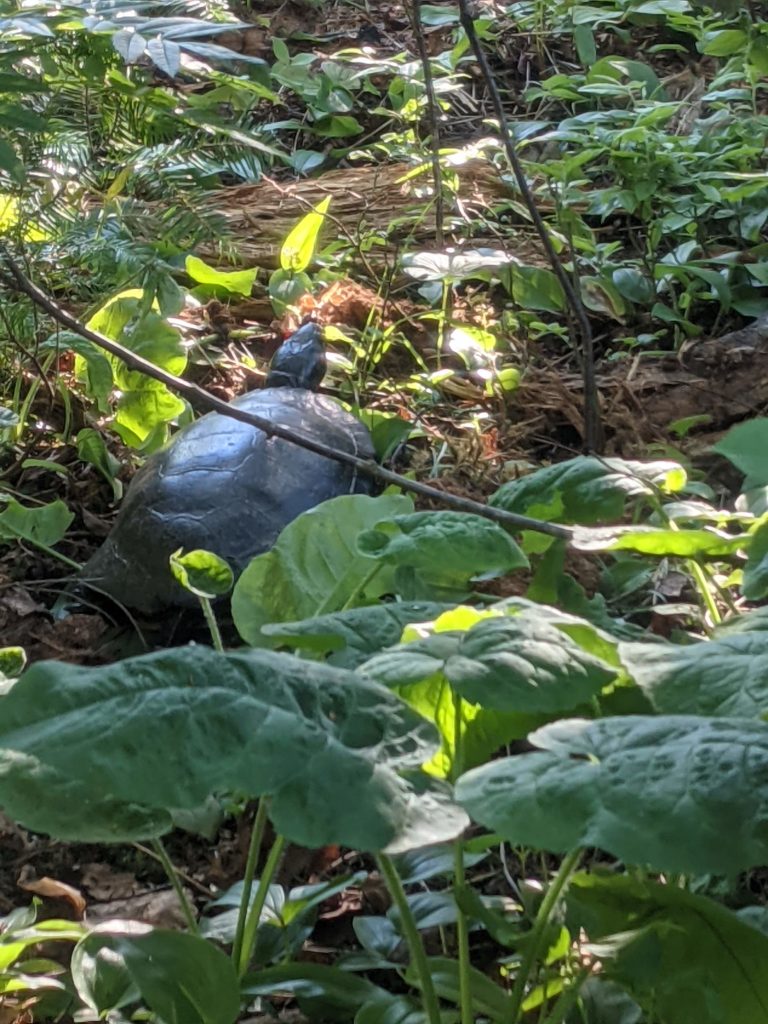
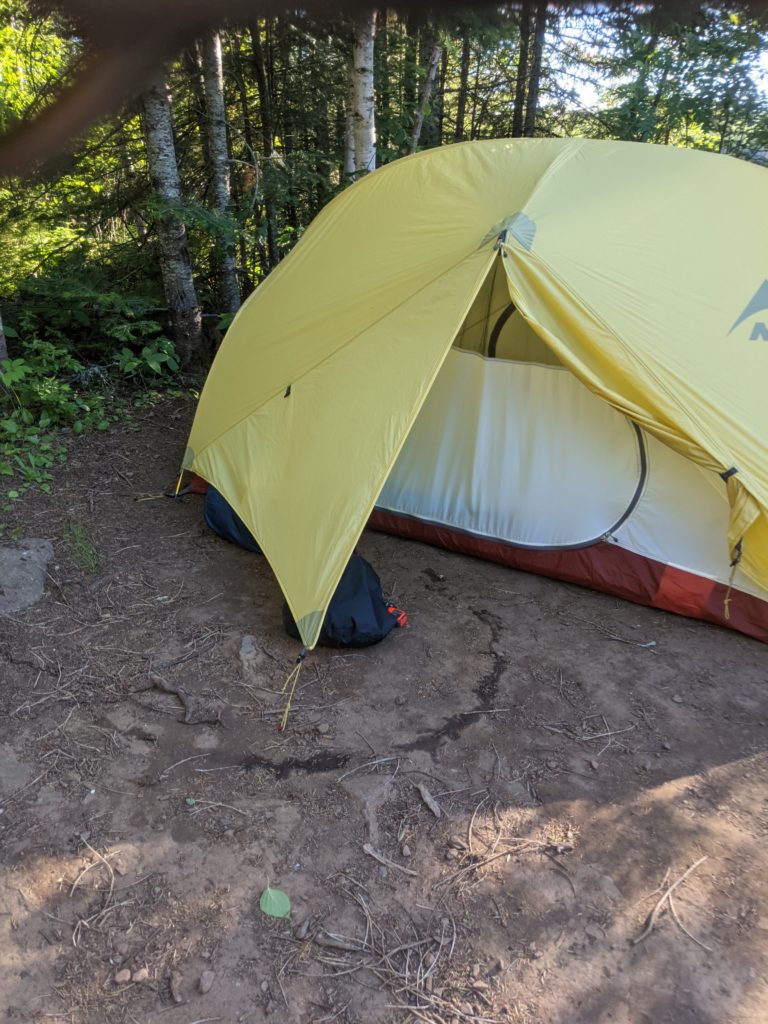
The wind did ultimately die down that evening, and by 6 pm things were pretty calm. We headed to bed by 8pm knowing that the following day – our third and final day – was going to be a long one to complete the loop up north to Cherokee and then back down to Sawbill.
Amidst an overcast sky, with a threat of rain that never materialized, we set off from our beautiful respite site after another breakfast of ramen and coffee. On the water by 7:30, conditions were quite different than the last time we were paddling. We headed northeast to the 55 rod portage into North Temperance, our first of 7 of the day (8 if you count the walk back home from the landing on Sawbill). The quick jaunt put us onto the scenic waterway with a long arm leading us to its western edge. A patch of sun filtered through as we paddled close to shore, our eyes peeled for turtles.
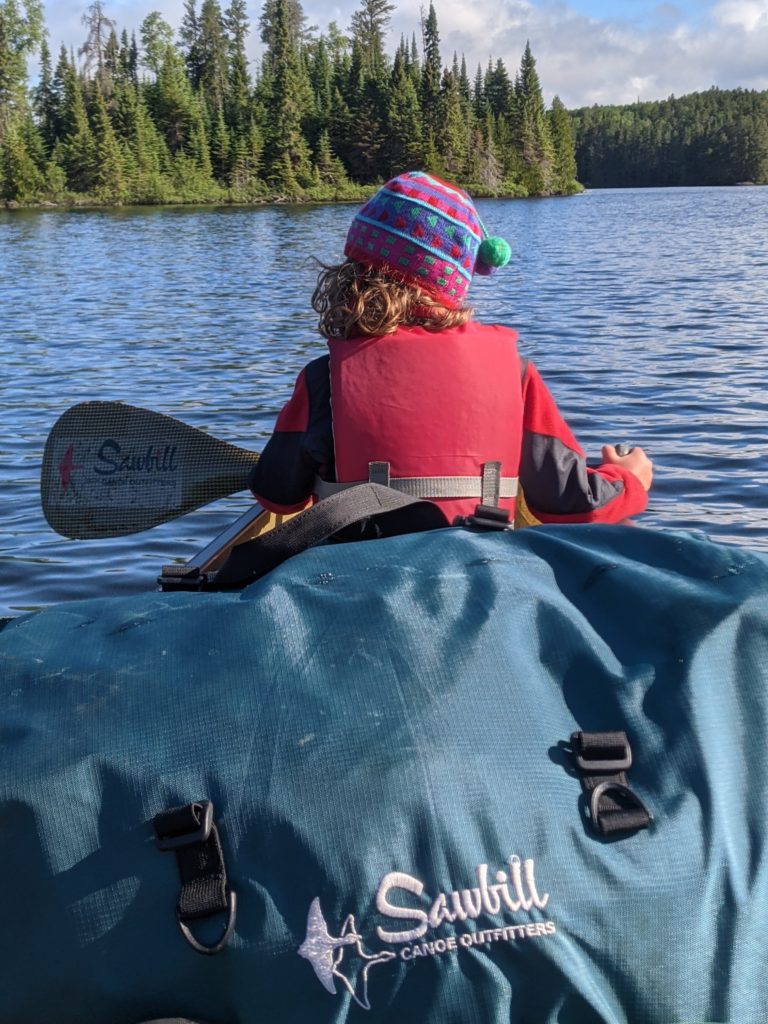
Another 105 rods of portaging and we were on the small Sitka Lake which we traversed in calm winds and grey skies. The following portage is tucked in a small bay that I wasn’t sure was the right spot, but Kit insisted we check it out. She was right. The 140 rod portage between Sitka and Cherokee is reminiscent of a mountain trail out west. Lots of elevation gain and loss in a somewhat rollercoaster fashion. Our leg muscles straining a bit more than normal, we cruised across without any breaks, taking the stone staircase down to a calm and grey Cherokee Lake.
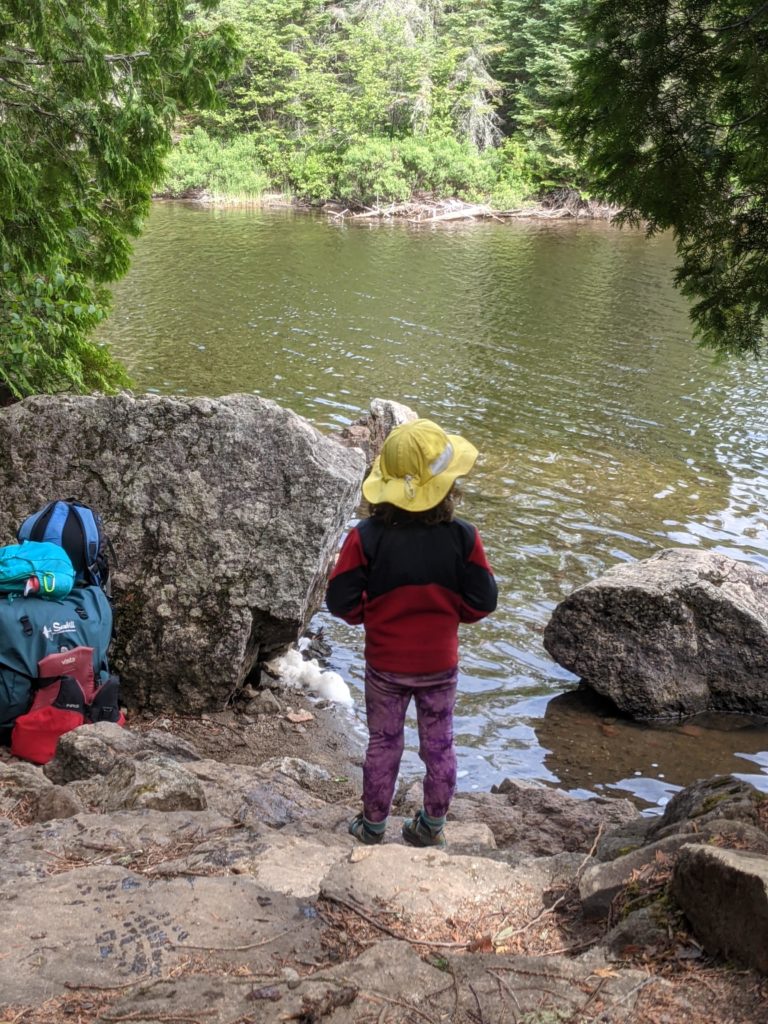
Open campsites abounded, and we ached a bit knowing that the two hours of travel we just completed had been planned to take place the day before. Conditions are always changing in the Wilderness, so a degree of flexibility is prudent to ensure a safe and enjoyable experience.
We skirted the south east shoreline with a light head wind that was swirling around the islands. Knowing the wind was coming from the north, we anxiously paddled on looking forward to our turn to the south. We stopped to drift and refill water one last time. Pulling into Cherokee Creak, the long east/west finger that usually welcomes people to Cherokee, presented us with a glassy surface and beautiful reflections. My partner in the bow was tickled for a calm opportunity to dunk lilly pads as we glided up the narrow passage. The water levels are a little low, so we were unable to make it all the way to the portage, a short mud slog and we were at the landing.
Readying ourselves for the longest portage of the day, and what really feels like the transition point from the interior of the Wilderness back to the fringe, we strapped on our gear and started walking straight south on the 180 rod portage. Arriving at the Skoop, Ada, Ada Creek complex, the map becomes a little less reliable regarding exact portage location and length. This section is pretty dynamic, constantly changing from the beaver activity and water levels. It’s prudent to take the portages where you can, and the places where you are able to paddle seem to be clear. A final 80 rod portage from Ada Creek and we were back on Sawbill Lake.
We took the opportunity to finally break for lunch before settling in for our long paddle down the entire length of Sawbill. We had our final lunch of peanut butter tortillas, string cheese, cookies and a few bonus pieces of Lindt chocolate.
We had only seen two groups since our time windbound on the South Temperance portage, but now that we were back on Sawbill, groups started appearing here and there as we wound through the islands on the north end, making our way through the narrows, and down the 4 mile corridor.
With a full stomach and cozied into her one-piece rain suit, Kit began to nod off as I paddled us south toward home. I suggested that she slink down to the floor of the canoe in front of her seat so she would have a backrest (and also not tumble out of the canoe). As she slept with her head on the gunwale, I enjoyed the mild tail wind below dark and dramatic cloud formations.
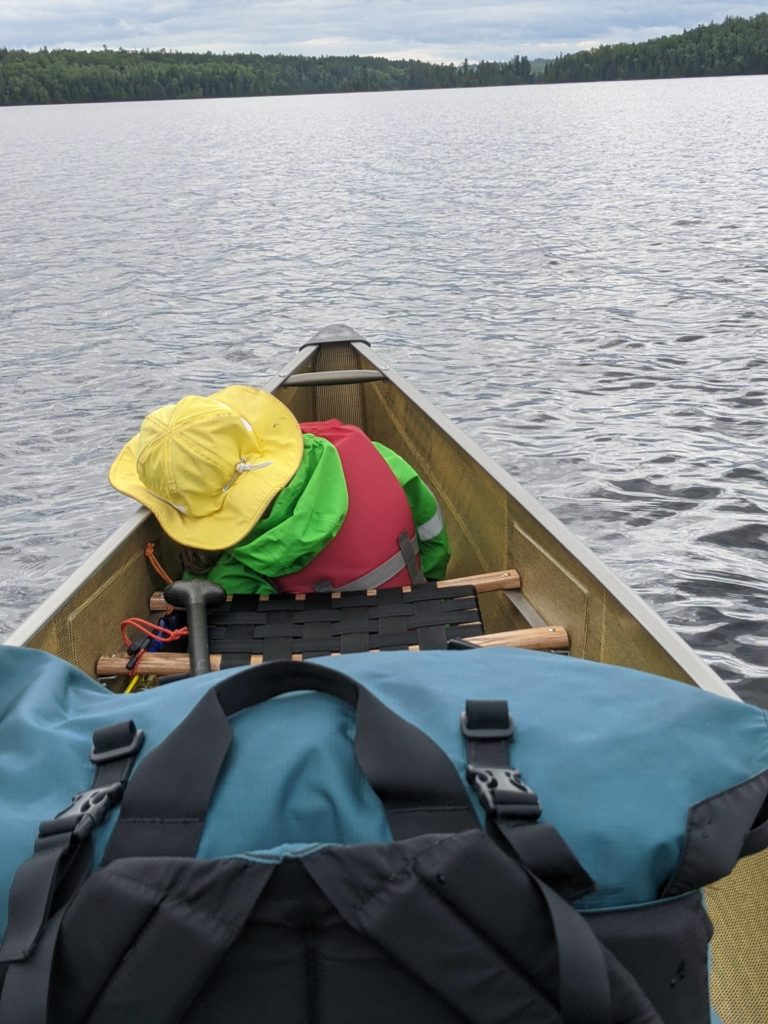
We made the landing about 9 hours after we began early that morning on South Temperance. Mom (Clare) and little brother (Sig) were just coming down to check our progress. Everyone was happy to reunite after our fun Wilderness adventure.
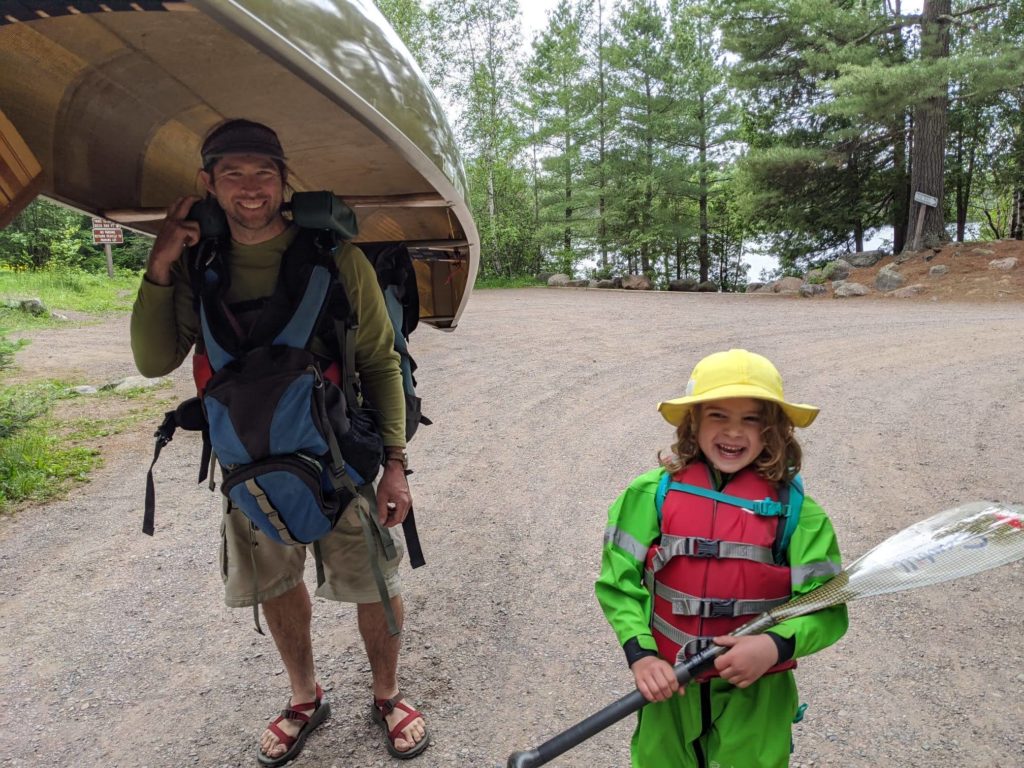
-Dan

